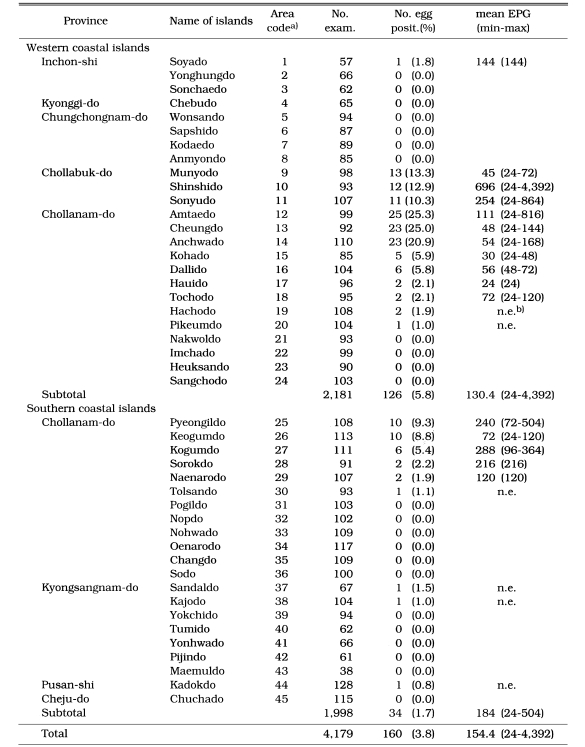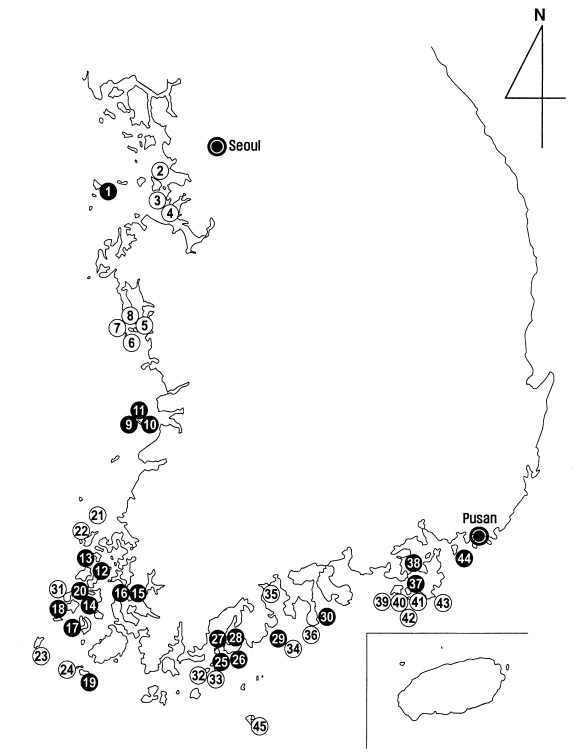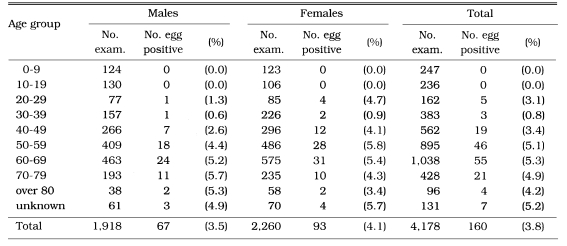Abstract
A nationwide survey was performed to know the distribution and prevalence of human Gymnophalloides seoi infection on western and southern coastal islands in the Republic of Korea. A total of 4,178 fecal specimens were collected from residents on 45 (24 western and 21 southern) islands, and examined by Kato-Katz and formalin-ether sedimentation techniques. Eggs of G. seoi were detected from 160 (3.8%) people living on 22 (13 western and 9 southern) islands. The prevalence varied by the location of islands; higher on western islands than on southern islands. The highest prevalence was found on Amtaedo (25.3%), followed by Cheungdo (25.0%), and Anchwado (20.9%) (Shinan-gun). A little lower prevalence was observed on Munyodo (13.3%), Shinshido (12.9%), and Sonyudo (10.3%) (Kunsan-shi). Of the remaining islands, the regions showing the prevalence greater than 5% included Kohado, Dallido (Mokpo-shi), Pyeongildo, Kogumdo (Wando-gun), and Keogumdo (Kohung-gun). A strong age predilection was noted (p < 0.05); 95% of the infected people were over 40 years old. Females showed a little higher prevalence than males. The results indicate that human G. seoi infection is more widely distributed than previously considered. Nine of 11 islands (excluding the 2 known areas Munyodo and Sunyudo) that showed greater prevalence than 5% are regarded as new endemic foci of G. seoi.
Keywords: Gymnophalloides seoi, gymnophallid, prevalence, human, Republic of Korea, western islands, southern islands
INTRODUCTION
Gymnophallid trematodes (Digenea: Gymnophallidae) were regarded as parasites commonly found in shore birds but not in humans (James, 1964: Ching, 1965, 1973); however, Gymnophalloides seoi was recently reported as a gymnophallid that could infect humans (Lee et al., 1993). Natural oysters, Crassostrea gigas, were proved to be the source of human infection with G. seoi (Lee et al., 1995a). A nationwide survey on local oysters collected from areas including Shinan-gun (Chollanam-do) and Buan-gun (Chollabuk-do) also showed that they were infected with G. seoi metacercariae (Lee et al., 1996). Later, Yubudo (Chungchongnam-do), Munyodo, Sonyudo (Chollabuk-do), and Chumoondo (Kangwha-gun, Inchon-shi) were added to the areas where G. seoi-infected oysters were distributed (Sohn et al., 1998).
The first human case of G. seoi was a 66-year-old Korean woman who complained of epigastric pain, indigestion, and diarrhea (Lee et al., 1993). She resided in a coastal village of Shinan-gun (Chollanam-do), that turned out to be a highly endemic area of G. seoi after an epidemiological survey; the prevalence was around 49% among the villagers (Lee et al., 1994). Subsequently, several epidemiological surveys were undertaken. Munyodo and Sunyudo of Kunsan-shi were found to be low endemic areas with 9.5% and 1.0% prevalence, respectively (Lee et al., 1999). Coastal villages in Muan-gun, Chollanam-do (Chai et al., 1997) and in Puan-gun, Chollabuk-do (Chai et al., 1998) were also found to have low prevalence. However, nationwide surveys have not been performed on the distribution and the prevalence of human G. seoi infection.
The present study was, therefore, performed in order to determine the distribution and the prevalence of human G. seoi infection on the western and southern coastal islands of the Republic of Korea.
MATERIALS AND METHODS
Areas and population surveyed
Out of a total of 454 islands in the Yellow (western) Sea and South (southern) Sea of the Republic of Korea, 45 (24 western and 21 southern) islands were surveyed (Table 1; Fig. 1) with respect to the population size and the ease of accessibility by boat. Therefore, relatively big islands such as Cheju-do and Chin-do were excluded from this study. The proportion of subjected people was about half when the island was small with less than 199 inhabitants, and about one-third when the island was bigger in size with more than 200 inhabitants. A total of 4,500 people were expected to examine; the number comprised of about 1% of the whole population of 450,000.
Table 1.
Results of fecal examinations for Gymnophalloides seoi eggs among the people residing on western and southern islands in the Republic of Korea.
a)Area code in Fig. 1.
b)n.e.: not examined.
Fig. 1.
Map showing the areas where the fecal specimens were collected and Gymnophalloides seoi eggs were found.(●, positive for G. seoi eggs; ○, negative for G. seoi eggs)
1) Islands in the western sea
Inchon-shi: Soyado (area code 1 in Table 1; Fig. 1), Yonghungdo (2), Sonchaedo (3) (Tokchok-myon, Ongjin-gun).
Kyonggi-do: Chebudo (4) (Soshin-myon, Hwasong-gun).
Chungchongnam-do: Wonsando (5), Sapshido (6), Kodaedo (7) (Ochon-myon, Poryong-shi), Anmyondo (8) (Anmyon-up, Taean-gun).
Chollabuk-do: Munyodo (9), Shinshido (10), Sonyudo (11) (Okto-myon, Kunsan-shi).
Chollanam-do: Amtaedo (12) (Amtae-myon), Cheongdo (13) (Cheongdo-myon), Anchwado (14) (Anchwa-myon, Shinan-gun), Kohado (15), Dallido (16) (Chungmu-dong, Mokpo-shi), Hauido (17) (Haui-myon), Tochodo (18) (Tocho-myon, Shinan-gun), Hachodo (19) (Chodo-myon, Chindo-gun), Pikeumdo (20) (Pikeum-myon, Shinan-gun), Nakwoldo (21) (Nakwol-myon, Yonggwang-gun), Imchado (22) (Imcha-myon), Heuksando (23) (Heuksan-myon, Shinan-gun), Sangchodo (24) (Chodo-myon, Chindo-gun).
2) Islands on the southern sea
Chollanam-do: Pyongildo (25) (Keumil-up, Wando-gun), Keogumdo (26) (Keumsan-myon, Kohung-gun), Kogumdo (27) (Koho-myon, Wando-gun), Sorokdo (28) (Toyang-up), Naenarodo (29) (Tongil-myon, Kohung-gun), Tolsando (30) (Tolsan-up, Yosu-shi), Pogildo (31) (Pogil-myon), Nopdo (32), Nohwado (33) (Nohwa-up, Wondo-gun), Oenarodo (34) (Ponglae-myon, Kohung-gun), Changdo (35) (Pulgyo-up, Posong-gun), Sodo (36) (Samsan-myon, Yosu-shi).
Kyongsangnam-do: Sandaldo (37) (Koje-myon), Kajodo (38) (Sadong-myon, Koje-shi), Yokchido (39), Tomido (40), Yonhwado (41) (Yokchi-myon), Pijindo (42), Maemuldo (43) (Hansan-myon, Tong-yong-shi).
Pusan-shi: Kadokdo (44) (Songbuk-dong, Kangso-gu).
Cheju-do: Chuchado (45) (Pukcheju-gun).
Fecal examination
A total of 4,178 fecal specimens, one specimen per person, were collected through branch offices of the Korea Association of Health, during July-August, 2000. They were transported to the Department of Parasitology, Seoul National University College of Medicine, and stored at 4℃. Formalin-ether sedimentation and Kato-Katz thick smear techniques were applied for examination of the feces. Eggs operculated, elliptical, 0.021-0.025 mm long and 0.011-0.015 mm wide, with thin and transparent shell, were regarded as those of G. seoi (Lee et al., 1993, 1994). Egg counting was done on each Kato-Katz smear, which contain about 41.7 mg fecal specimen per smear. Thus the number of G. seoi eggs per gram (EPG) of feces was calculated as; EPG = 24 × number of eggs on each Kato-Katz smear.
RESULTS
Of 4,178 fecal specimens examined, 160 (3.8%) appeared positive for eggs of G. seoi. Other parasite eggs and cysts were also detected, but the results are to be reported separately. The egg positive cases of G. seoi were found from 22 (48.9%) of 45 islands surveyed. The geographical distribution of the egg positive cases was unexpectedly wide, from northwestern to southeastern coastal islands (Table 1; Fig. 1).
The egg positive rate of G. seoi was the highest in Amtaedo (25.3%), followed by Cheungdo (25.0%), Anchwado (20.9%), Munyodo (13.3%), Shinshido (12.9%), Sonyudo (10.3%), Pyongildo (9.3%), Kogumdo (8.8%), Kohado (5.9%), Dallido (5.8%), and Kogumdo (5.4%) (Table 1). Islands which revealed lower prevalences than 5% were Keogumdo (2.2%), Tochodo (2.1%), Hauido (2.1%), Hajodo (1.9%), Naenarodo (1.9%), Soyado (1.8%), Sandaldo (1.5%), Tolsando (1.1%), Pikeumdo (1.0%), Kajodo (1.0%), and Kadokdo (0.8%) (Table 1).
Among the egg positive cases of G. seoi, the EPG per individual ranged from 24 to 4,392, and averaged 154.4 (n = 153). According to different islands, the average EPG was the highest in Shinshido (696), followed by Kogumdo (288), Sonyudo (254), Pyeongildo (240), Sorokdo (216), Soyado (144), Naenarodo (120), Amtaedo (111), Tochodo (72), Keogumdo (72), Dallido (56), Anchwado (54), Cheungdo (48), Munyodo (45), Kohado (30), and Hauido (24) (Table 1).
The egg positive rate of G. seoi varied also by the age group of the subjected people. The highest rate was observed in age group 60-69 years (5.3%), followed by age groups 50-59 years (5.1%), 70-79 years (4.9%), over 80 years (4.2%), 40-49 years (3.4%), 20-29 years (3.1%), and 30-39 years (0.8%) (Table 2). The younger people below 19 years of age were all negative for G. seoi eggs (Table 2). The differences in the prevalence by different age groups were statistically significant (p < 0.05). Females (4.1%) showed a little higher positive rate than males (3.5%), but the difference between sex was statistically not significant (p > 0.05) (Table 2).
Table 2.
Age and sex prevalence of Gymnophalloides seoi among the inhabitants on western and southern coastal islands in the Republic of Korea
DISCUSSION
The areas where G. seoi-infected humans have been located so far include coastal villages in Shinan-gun (Aphaedo) (Lee et al., 1994; Chai et al., 2000), Muan-gun (Chai et al., 1997), Puan-gun (Chai et al., 1998), and Kunsan-shi (Munyodo and Sunyudo) (Lee et al., 1999). Among them, the village on Aphaedo, Shinan-gun has been the most well known endemic area with high, persistent endemicity for the past 6 years (Chai et al., 2000). It is of considerable interest to note that a human case infected with G. seoi stated that he had consumed raw oysters in Kangwhado, Inchon-shi, which is near to Seoul (Lee et al., 1995b).
The natural definitive host other than man was reported to be the oystercatcher Haematopus ostralegus (Ryang et al., 2000), a species of birds eating oysters. These birds are known to migrate along the tidal flat of the Yellow Sea, the Republic of Korea (Won, 1993). On the other hand, C. gigas, natural oysters which are the second intermediate host of G. seoi, are known to be available from the southern coastal areas to the western coastal areas of the Republic of Korea (Shim et al., 1998). In this respect, the geographical distribution of G. seoi could be expected to be more diverse than ever reported.
The present study located 22 coastal islands with G. seoi-infected people. Except for Munyodo and Sunyudo (Lee et al., 1999), 20 are found to be new areas of prevalence of human infections with this gymnophallid. For convenience, the areas of over 20.0%, 10.0-19.9%, and 5.0-9.9% prevalences were designated as high, moderate, and low endemic areas, respectively. According to such grouping, 3 islands (Amtaedo, Cheongdo, and Anchwado) were highly endemic, 3 (Shinshido, Munyodo, and Sunyudo) were moderately endemic, and 5 (Kohado, Dallido, Pyeongildo, Keogumdo, and Kogumdo) were low endemic areas. It should be retained to regard the remaining 11 areas as endemic areas of G. seoi, because only a few (1-2) people on each island were infected with this fluke, and their infection might have been acquired from other endemic areas.
Among the 20 newly found areas of human G. seoi infection, included were 11 islands not far from the previously reported areas. Amtaedo, Cheongdo, Anchwado, Hauido, Dochodo, Pikeumdo (Shinan-gun), Kohado, Dallido (Mokpo-shi), and Hachodo (Chindo-gun) are all close to Aphaedo (Shinan-gun), the most well known endemic area (Lee et al., 1994). Oysters collected around these areas were found to have G. seoi metacercariae (Lee et al., 1996). Shinshido is a small island close to the already-known endemic areas including Puan-gun (Chai et al., 1998), and Munyodo and Sunyudo (Lee et al., 1999). Soyado is located southwest of Kangwhado where a human case was reported (Lee et al., 1995b).
The remaining 9 islands were located in the southern sea (Chollanam-do, Kyongsangnam-do, or Pusan-shi), very remote from the known endemic areas. A group of 4 islands (Pyeongildo, Keogumdo, Kogumdo, and Sorokdo), very close to one another, are of considerable interest. The prevalence on these islands was relatively low, and the infection status of oysters around these areas is unknown. However, special attention should be paid on these islands in the future. Still remained 5 islands are scattered, and only a few infected cases were found on each island.
The presence of human infections with G. seoi on the southern islands is highly interesting, since there are only a few existing oystercatchers along the southern coasts (Won, 1993), and oysters caught from several places of southern coasts were found free of G. seoi (Lee et al., 1996). Therefore, several possibilities could be raised. Firstly, the eggs detected from humans on southern islands may not be G. seoi but the eggs of other gymnophallid species. In this respect, it is worthwhile to note that more than 2 gymnophallid species Parvatrema timondavidi (Yu et al., 1993) and Meiogymnophallus sp. (unpublished observation) exist in the Republic of Korea. The former is transmitted by a marine bivalve Tapes philippinarum (Yu et al., 1993), and the latter by the razor clams (unpublished observation). These molluscan species are at times eaten raw by the local Korean people, although their capability of infecting humans is yet unknown. To rule out this possibility, the recovery and the identification of the adult flukes from the egg positive cases on southern islands should be essential.
Secondly, if the detected eggs are of G. seoi, there may exist a new second intermediate host other than the oysters. For example, a pulmonate gastropod Melampus bidentatus could play the role of a second intermediate host for Gymnophalloides heardi (Ching, 1995). However, this possibility is not likely, considering the high host specificity of gymnophallid species for their molluscan (first and second intermediate) hosts.
A third possibility is that there may be new definitive hosts other than the oystercatchers and man. This seems to be highly possible, since the host specificity of G. seoi for the definitive host is considerably low. For example, mammals including humans (Lee et al., 1994), laboratory mice, rats, hamsters, gerbils, and cats (Lee et al., 1997), and birds such as oystercatchers (Ryang et al., 2000) and plovers (Ryang et al., 2001) are all fairly susceptible to G. seoi infection. In Gymnophalloides heardi, a related species, a rodent Oryzomys palustris was reported as the natural definitive host (Ching, 1995). In this respect, further studies are required to find out new definitive hosts for G. seoi.
The results of the present study clearly indicate that human G. seoi infection is more widely distributed than previously considered. Excluding the 2 known areas (Munyodo and Sunyudo), 9 of 11 islands that showed greater prevalence than 5% are regarded as new endemic foci of G. seoi.
ACKNOWLEDGEMENTS
The authors are grateful to the members of Kyonggi, Inchon, Chungnam, Chonbuk, Chonnam, Kyongnam, Pusan, and Cheju Branch Offices as well as the Headquarter of the Korea Association of Health for their assistance in collecting fecal specimens.
Footnotes
This study was supported by a grant from Korea Association of Health (2000).
References
- 1.Chai JY, Kim IM, Seo M, et al. A new endemic focus of Heterophyes nocens, Pygidiopsis summa, and other intestinal flukes in a coastal area of Muan-gun, Chollanam-do. Korean J Parasitol. 1997;35:233–238. doi: 10.3347/kjp.1997.35.4.233. [DOI] [PubMed] [Google Scholar]
- 2.Chai JY, Lee GC, Park YK, et al. Persistent endemicity of Gymnophalloides seoi infection in a southwestern coastal village of Korea with speical reference to its egg laying capacity in the human host. Korean J Parasitol. 2000;38:51–57. doi: 10.3347/kjp.2000.38.2.51. [DOI] [PMC free article] [PubMed] [Google Scholar]
- 3.Chai JY, Song TE, Han ET, et al. Two endemic foci of heterophyids and other intestinal fluke infections in southern and western coastal areas in Korea. Korean J Parasitol. 1998;36:155–161. doi: 10.3347/kjp.1998.36.3.155. [DOI] [PMC free article] [PubMed] [Google Scholar]
- 4.Ching HL. Life cycles of Lacunovermis conspicuus n. gen., n. sp. and Meiogymnophallus multigemmulus n. gen., n. sp. (Gymnophallidae: Trematoda) from Macoma inconspicua and diving ducks from Vancouver, Canada. Proceed Helminthol Soc Wash. 1965;32:53–63. [Google Scholar]
- 5.Ching HL. Description of Gymnophallus somateriae (Levinsen, 1881) from Macoma inconspicua and diving ducks from Vancouver, Canada. Can J Zool. 1973;51:801–806. doi: 10.1139/z73-119. [DOI] [PubMed] [Google Scholar]
- 6.Ching HL. Four new gymnophallid digeneans from rice rats, willets, and molluscs in Florida. J Parasitol. 1995;81:924–928. [PubMed] [Google Scholar]
- 7.James BL. The life cycle of Parvatrema homoeotecnum sp. nov. (Trematoda: Digenea) and a review of the family Gymnophallidae Morozov, 1955. Parasitology. 1964;54:1–41. [Google Scholar]
- 8.Lee KJ, Park GN, Ahn YK, et al. Surveys on Gymnophalloides seoi infection in the Gogunsan Gundo (Islands) of Korea. Korean J Malacol. 1999;15:121–125. [Google Scholar]
- 9.Lee SH, Chai JY, Hong ST. Gymnophalloides seoi n. sp. (Digenea: Gymnophallidae), the first report of human infection by a gymnopallid. J Parasitol. 1993;79:677–680. [PubMed] [Google Scholar]
- 10.Lee SH, Chai JY, Lee HJ, et al. High prevalence of Gymnophalloides seoi infection in a village on a southwestern island of the Republic of Korea. Am J Trop Med Hyg. 1994;51:281–285. doi: 10.4269/ajtmh.1994.51.281. [DOI] [PubMed] [Google Scholar]
- 11.Lee SH, Chai JY, Seo M, Choi MH, Kim DC, Lee SK. Two cases of Gymnophalloides seoi infection accompanied by diabetes mellitus. Korean J Parasitol. 1995b;33:61–64. doi: 10.3347/kjp.1995.33.1.61. [DOI] [PubMed] [Google Scholar]
- 12.Lee SH, Choi MH, Seo M, Chai JY. Oysters, Crassostrea gigas, as the second intermediate host of Gymnophalloides seoi (Gymnophallidae) Korean J Parasitol. 1995a;33:1–7. doi: 10.3347/kjp.1995.33.1.1. [DOI] [PubMed] [Google Scholar]
- 13.Lee SH, Park SK, Seo M, Guk SM, Choi MH, Chai JY. Susceptibility of various species of animals and strains of mice to Gymnophalloides seoi infection and the effects of immunosuppression in C3H/HeN mice. J Parasitol. 1997;83:883–886. [PubMed] [Google Scholar]
- 14.Lee SH, Sohn WM, et al. A nationwide survey of naturally produced oysters for infection with Gymnophalloides seoi metacercariae. Korean J Parasitol. 1996;34:107–112. doi: 10.3347/kjp.1996.34.2.107. [DOI] [PubMed] [Google Scholar]
- 15.Ryang YS, Yoo JC, Lee SH, Chai JY. The palearctic oystercatcher Haematopus ostralegus, a natural definitive host for Gymnophalloides seoi. J Parasitol. 2000;86:418–419. doi: 10.1645/0022-3395(2000)086[0418:TPOHOA]2.0.CO;2. [DOI] [PubMed] [Google Scholar]
- 16.Ryang YS, Yoo JC, Lee SH, Chai JY. Susceptibility of avian hosts to experimental Gymnophalloides seoi infection. J Parasitol. 2001;87 doi: 10.1645/0022-3395(2001)087[0454:SOAHTE]2.0.CO;2. (in press) [DOI] [PubMed] [Google Scholar]
- 17.Shim WJ, Oh JR, Kahng SH, Shim JH, Lee SH. Accumulation of tributyl and triphenyltin compounds in Pacific oyster, Crassostrea gigas, from the Chinhae Bay System, Korea. Arch Environ Contam Toxicol. 1998;35:41–47. doi: 10.1007/s002449900346. [DOI] [PubMed] [Google Scholar]
- 18.Sohn WM, Ryang YS, Chai JY, Lee SH. Discovery of Gymnophalloides seoi metacercariae in oysters from islands of the West Sea known as the habitats of paleartic oystercatchers. Korean J Parasitol. 1998;36:163–169. doi: 10.3347/kjp.1998.36.3.163. [DOI] [PMC free article] [PubMed] [Google Scholar]
- 19.Yu JR, Chai JY, Lee SH. Parvatrema timondavidi (Digenea: Gymnophallidae) transmitted by a clam, Tapes philippinarum, in Korea. Korean J Parasitol. 1993;31:7–12. doi: 10.3347/kjp.1993.31.1.7. [DOI] [PubMed] [Google Scholar]
- 20.Won PO. A field guide to the birds of Korea. Seoul, Korea: Bumyangsa; 1993. pp. 71–74. (in Korean) [Google Scholar]





